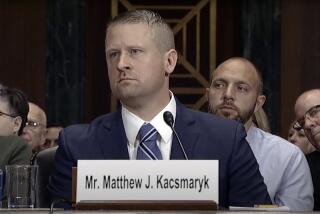High Court to Hear Missouri Case : O’Connor Expected to Cast Decisive Vote on Abortion
- Share via
WASHINGTON — In 1981, when President Ronald Reagan announced his surprise choice of a woman to serve on the Supreme Court, everyone’s first question was: Who is Sandra Day O’Connor?
Close behind was a second: What is her position on abortion?
For eight years, O’Connor has kept her views on that divisive issue shrouded in considerable mystery. But now, in a Missouri case to be argued before the court on April 26 and decided before the court ends its current term at the end of June, she is likely to cast the decisive vote on the authority of states to restrict abortions.
The decision could become a legal landmark as well as a turning point in the nationwide abortion debate. Pro-choice advocates hope O’Connor will join a majority of justices in affirming the 1973 Roe vs. Wade decision legalizing abortion. Anti-abortion activists want her to side with the court’s conservative faction in reversing or at least rewriting that ruling.
Both sides may be disappointed. Most legal experts expect O’Connor to chart a middle course, one that gives states more authority to regulate abortion but not to ban it.
“She is in a very tough position,” said Gene Nichol, dean of the University of Colorado Law School. “She’s a Reagan appointee, a conservative, . . . someone who believes the court should defer to state legislatures. But she has also taken a strong stand for equality for women.”
“It’s hard to imagine,” noted University of Virginia law professor A.E. Dick Howard, “that she would want to be remembered as the woman who overturned Roe vs. Wade.”
O’Connor’s pivotal role is likely to be repeated time and again as the balance of power on the high court shifts to the right. With the retirement of moderate Justice Lewis F. Powell Jr. and the appointment of conservative Anthony M. Kennedy to replace him, O’Connor is now perceived as the justice closest to the center of ideological spectrum on the nine-member court. That is likely to make her the swing vote in many key decisions.
None is potentially more explosive than the abortion issue. The clash between pro-choice advocates and anti-abortion activists has escalated into a national drama reminiscent of the civil rights and anti-war movements of the 1960s and early 1970s. A rally organized by supporters of legalized abortion drew more than 300,000 people in Washington last Sunday.
O’Connor’s past writings on abortion reflect her middle-of-the-road inclinations. In two lengthy dissenting opinions to 1983 and 1986 rulings rejecting state restrictions on abortions, she argued that:
--The Supreme Court has gone too far in striking down state statutes simply because they restrict abortion in some way.
--A state has a “compelling interest in the protection of human life . . . throughout pregnancy,” not just in its latter stages. In Roe vs. Wade, the court said the state’s interest in protecting the fetus becomes compelling only after about 24 to 28 weeks of pregnancy, when the baby can live outside its mother.
Cites ‘Undue Burden’
--Reasonable abortion regulations should be upheld unless they impose “an undue burden” on a woman’s right to choose.
Some legal experts believe that the court could use O’Connor’s “undue burden” standard to find a compromise between seemingly irreconcilable positions. It depends on how “undue burden” is defined.
In her 1986 dissenting opinion, O’Connor said that an undue burden “will generally be found in situations involving absolute obstacles or severe limitations on the abortion decision, not wherever a state regulation may inhibit abortions to some degree.”
In the view of some legal experts, that standard is closer in spirit to the original Roe vs. Wade opinion than more recent court rulings are.
In the court’s landmark 1973 decision, Justice Harry A. Blackmun said the 14th Amendment, which holds that no state shall deprive a person of life, liberty or property, is “broad enough to encompass a woman’s decision whether or not to terminate her pregnancy.”
Seeks Balance
But a woman’s right to have an abortion is not absolute, Blackmun wrote for the 7-2 majority, and must be balanced against the “important and legitimate (state) interest in protecting the potentiality of human life.”
The high court’s pro-choice faction grew more rigid, however, as anti-abortion activists won repeated victories in state legislatures during the 1970s and early 1980s. In a 1986 abortion ruling, the court voted 5 to 4 to strike down a series of Pennsylvania abortion regulations, including a requirement that women seeking abortions must be offered a pamphlet describing possible medical risks.
These regulations were unconstitutional, Blackmun wrote, because they “posed an unacceptable danger of deterring the exercise” of a woman’s right to choose.
To critics, including O’Connor, the high court had moved far beyond its initial position that laws prohibiting abortion were unconstitutional. Instead, the critics held, the court found any regulations unconstitutional if they might deter a woman from seeking an abortion.
As examples of legitimate state restrictions rejected by the high court’s pro-choice majority, O’Connor has cited regulations requiring a woman to wait 24 hours before going ahead with an abortion and mandating that abortions administered during a woman’s second trimester take place in a hospital.
Writes 1986 Dissent
In her 1986 dissent, O’Connor wrote: “Today’s decision makes it painfully clear that no legal rule or doctrine is safe from ad hoc nullification by this court when it . . . arises in a case involving state regulation of abortion.”
Anti-abortion activists are confident that O’Connor’s position, if it becomes decisive in the Missouri case, will open the way for an array of new abortion regulations.
“I think she wants to go back over those 16 years (since the Roe ruling) and uphold a lot of regulations that have been struck down,” said Maura Quinlan, a Harrisburg, Pa., attorney who filed a court brief in the Missouri case on behalf of members of the Pennsylvania Legislature.
Quinlan said that affected regulations could range from requiring counseling on abortion alternatives such as adoption to banning abortions sought for purposes of “sex selection.”
The impact could extend to a 1987 California law prohibiting unmarried girls under the age of 18 from obtaining an abortion without the consent of one parent. That law has been put on hold pending a court challenge.
“We will write new statutes, try them out and test them in courts,” Quinlan said. “Only time will tell how far she will go.”
For the same reason, pro-choice activists find O’Connor’s position troubling. She has not clearly stated what kind of abortion restrictions would place an “undue burden” on the rights of a pregnant woman. Similarly, her past writings appear to support the right to choose, but she has not asserted that the right is fundamental under the Constitution.
“I’m not optimistic about O’Connor,” said New York University law professor Sylvia Law, a pro-choice advocate. “We haven’t yet seen an abortion restriction that she would strike down. I think she will give lip service to the abortion right, but do nothing to protect it.”
Law believes O’Connor will not join a new court majority in throwing out Roe vs. Wade. In the 1986 case, she points out, O’Connor pointedly did not join White’s dissenting opinion stating that Roe should be overturned.
Rather, Law fears that O’Connor’s defense of the right to choose an abortion will prove so weak that anti-abortion legislatures will be able to enact effective roadblocks to exercising the right.
If Roe is either overruled or weakly affirmed, “you are going to have trench warfare in the state legislatures,” Law said. “Our only slim hope is that she will see abortion as having something to do with women and equality.”
Department Files Brief
In a friend-of-the-court brief in the Missouri case, the Justice Department suggested that the court might overturn Roe vs. Wade and let state legislatures resolve the “divisive conflict between a woman’s interest in procreative choice and the state’s interest in protecting the life of an unborn child.”
The justices have received plenty of additional advice in more than 70 briefs filed in the Missouri case.
Some anti-abortion activists have urged the court to make abortion unconstitutional, a position adopted last year in the Republican Party platform. So far, no justice has voiced support for that position.
At the other extreme, women’s rights groups have urged the court to make abortion off-limits to any state regulations. Four justices have favored that approach: Blackmun, William J. Brennan Jr., Thurgood Marshall and John Paul Stevens.
The case before the court (Webster vs. Reproductive Health Services, 88-605) tests five provisions of a Missouri law drafted by an anti-abortion group and approved overwhelmingly by the state Legislature in 1986. The provisions are:
--A declaration that “the life of each human being begins at conception.”
--A requirement that a doctor who believes a woman is carrying an unborn child of 20 or more weeks undertake medical tests to see whether the child is viable.
Limits Public Funds
--A ban on use of public funds for performing or assisting an abortion, except to save a mother’s life.
--A prohibition against public employees’ assisting in an abortion or encouraging a woman to have one, except to save her life.
--A ban on use of any public facility for an abortion or for counseling on abortion, except to save a woman’s life.
Last year, the U.S. 8th Circuit Court of Appeals struck down the law. Applying the strict doctrine expressed by the Supreme Court in 1986, the appeals court said the Missouri law was unconstitutional because it was intended to deter women from obtaining abortions.
Both sides in the case conceded that the law had little practical impact. More than 95% of abortions in Missouri take place in private clinics and would be unaffected by the law, according to court documents. Nevertheless, Missouri Atty. Gen. William L. Webster filed an appeal and suggested that the Supreme Court could use the case to reconsider the Roe ruling.
Catholic University law professor Robert A. Destro predicted that the court, with O’Connor setting the tone, would merely decide the narrow issues posed by the Missouri case. O’Connor, he said, “is a careful thinker and cautious. She seems to want to change Roe, but not to throw it away entirely.”
Justice Blackmun, discussing O’Connor’s position on a state-sanctioned death penalty for minors during a talk to law students, offered another analysis of the court’s only woman justice.
“Sandra’s tough. She’s conservative. She’s a states’ righter,” Blackmun said. But, he added: “The soft spots in her armor . . . are children and women.”
More to Read
Sign up for Essential California
The most important California stories and recommendations in your inbox every morning.
You may occasionally receive promotional content from the Los Angeles Times.














